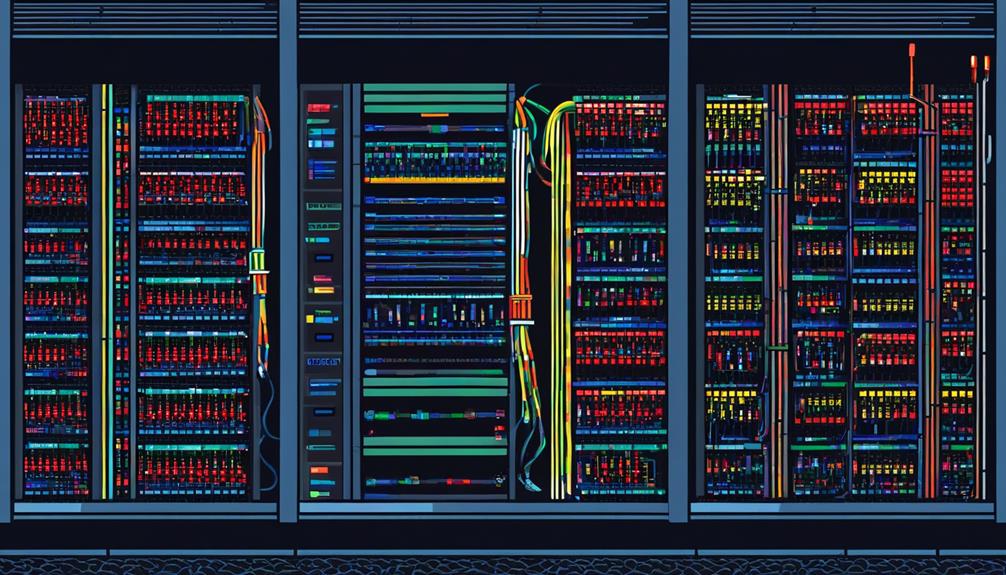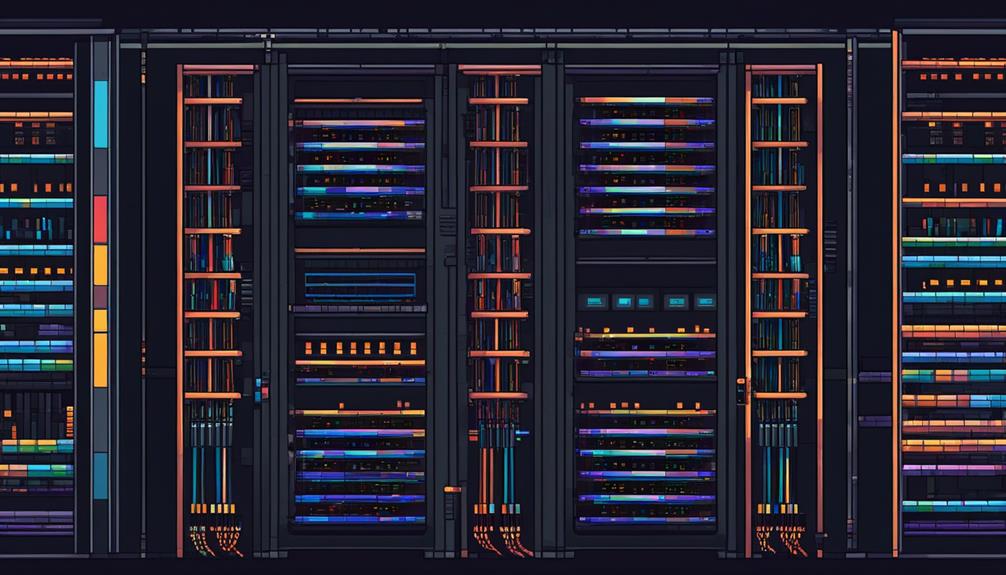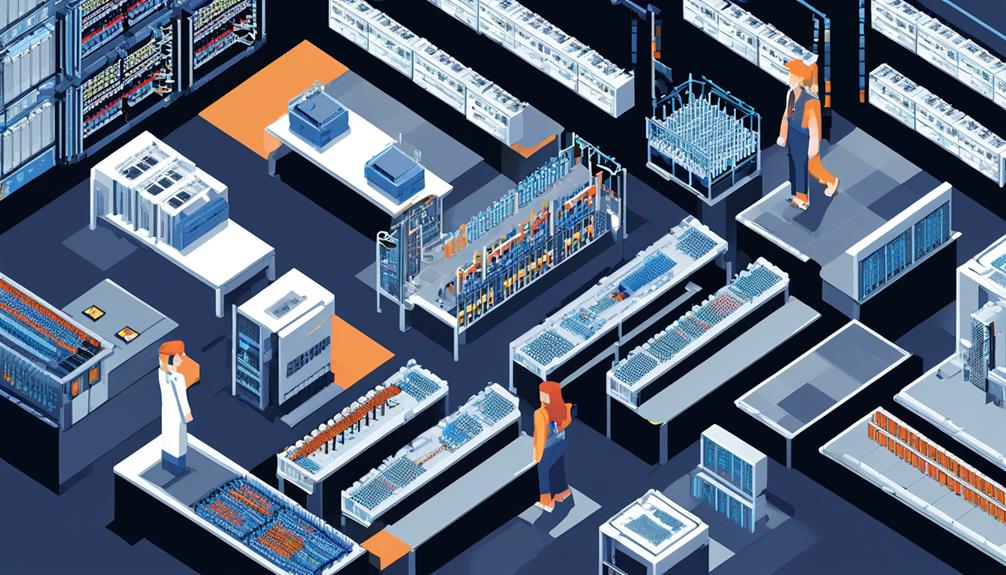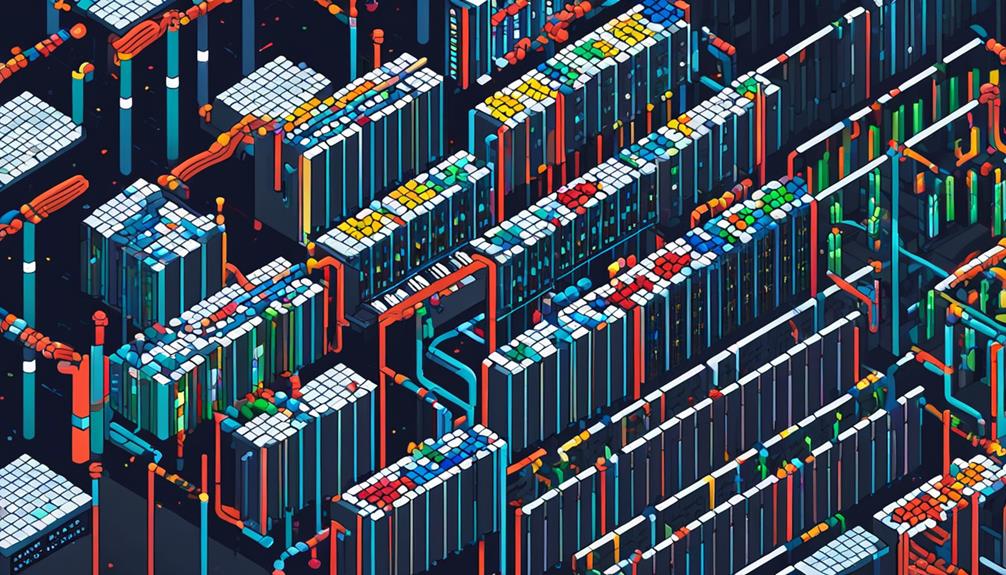Data center cabling standards play a crucial role in ensuring the efficiency and reliability of data center operations. These guidelines provide a structured approach to cable installation, organization, and management, promoting safety and optimizing performance. By adhering to these standards, data center professionals can simplify maintenance and troubleshooting, resulting in a robust and scalable infrastructure.
However, with evolving technologies and increasing data demands, it is essential to stay up-to-date with the latest industry-recognized cabling standards and best practices. In this discussion, we will explore the types of data center cabling, delve into the importance of cable management, and highlight key considerations for data center consolidation and colocation provider selection.
Stay tuned to discover valuable insights from the data center community that will help you navigate the complex world of data center cabling.
Key Takeaways
- TIA/EIA standards and ISO/IEC standards are industry-recognized guidelines for data center cabling, ensuring reliability, security, and environmental protection.
- Compliance with cabling standards leads to efficiency, reduced downtime, and improved network performance.
- Effective cable management techniques such as labeling, routing, and the use of cable trays and racks are crucial for optimal performance and organization in data centers.
- Fiber optic cabling offers advantages over copper cabling, including faster data transfer, greater bandwidth, and immunity to electromagnetic interference. Proper installation, maintenance, and testing are necessary for optimal performance and reliability.
Types of Data Center Cabling

One of the essential components of structured cabling in data centers is the utilization of various types of cabling, including twisted pair copper and fiber optic cabling, to support a wide range of applications. Structured cabling systems provide a standardized approach to data center cable management, ensuring a well-organized and efficient infrastructure.
Copper cables, such as twisted pair cables, are commonly used in data centers. These cables consist of multiple pairs of insulated copper wires twisted together, providing reliable transmission of data signals. Twisted pair copper cables are available in different categories, such as Cat 5e, Cat 6, and Cat 6a, each offering varying levels of bandwidth and performance. These cables are often used for shorter distance connections, such as within server racks or between network switches.
On the other hand, fiber optic cables offer high-speed data transmission over long distances and are ideal for interconnecting data center equipment. These cables use thin strands of glass or plastic to transmit data as pulses of light. Fiber optic cables provide greater bandwidth and immunity to electromagnetic interference compared to copper cables. They are commonly used for backbone connections, connecting data centers across different floors or buildings, and for long-distance connections to external networks.
Structured cabling systems incorporate both copper and fiber optic cables to ensure a versatile and reliable infrastructure. By utilizing the appropriate cable types for different applications, data centers can achieve efficient data transmission, support scalability, and maintain optimal network performance.
Additionally, proper cable management practices, including labeling, routing, and organizing cables, contribute to improved airflow, simplified maintenance, and easier troubleshooting within the data center environment.
Industry-Recognized Cabling Standards
Industry-recognized cabling standards play a crucial role in ensuring the reliability and efficiency of data center infrastructure. The TIA/EIA standards, including ANSI/TIA-942 and the ISO/IEC standards such as ISO/IEC 24764, provide comprehensive guidelines for planning, construction, protection, management, and maintenance of data center cabling.
Adhering to these standards, particularly the ANSI/TIA-568-C standard for structured cabling, is essential for maintaining consistency, optimizing performance, and ensuring the integrated and secure operation of data center infrastructure.
TIA/EIA Standards
The TIA/EIA Standards are a set of industry-recognized cabling standards that provide comprehensive guidelines for the planning, construction, protection, management, and maintenance of data center cabling infrastructure. These standards ensure the reliability, security, and environmental protection of data centers. Compliance with TIA/EIA Standards ensures interoperability and consistent performance of the cabling infrastructure.
Key standards such as ANSI/TIA-942, ISO/IEC 24764, and ANSI/BICSI 002-2014 provide guidelines for data center cabling design and operations. The TIA/EIA Standards address important aspects such as power and data cabling separation, emphasizing the significance of performance, safety, and compliance with codes.
ISO/IEC Standards
ISO/IEC Standards are widely accepted industry cabling standards utilized for data center cabling. These standards provide guidelines for safety, integrated infrastructure, and consistency in cabling installations.
Compliance with ISO/IEC standards, such as ISO/IEC 24764, ensures reliability, security, and environmental protection in data center cabling. This standard specifies the cabling used in data centers based on TIA-942 and EN 50173-5.
Following ISO/IEC Standards helps in ensuring interoperability and consistent performance in cabling infrastructure. With these standards in place, data centers can achieve a higher level of efficiency, reduce downtime, and improve overall network performance.
ANSI/TIA-568-C Standard
The ANSI/TIA-568-C Standard establishes guidelines for the design and installation of twisted-pair copper cabling systems in data centers, ensuring the interoperability and consistent performance of the infrastructure.
This standard plays a crucial role in data center cabling by providing structured cabling requirements that ensure reliable and efficient communication between various network devices. It covers specifications for connectors, cabling, and cross-connections within the telecommunications infrastructure.
The ANSI/TIA-568-C Standard also defines performance requirements for different categories of twisted pair cabling systems, ensuring that data centers meet industry standards for transmission quality and capacity. Compliance with this standard is essential for data centers to achieve reliable and high-performing cabling installations, enabling seamless data transfer and communication throughout the network infrastructure.
Importance of Cable Management in Data Centers
Effective cable management is crucial for optimal performance and organization in data centers.
By employing cable organization techniques, such as proper labeling and routing, data centers can benefit from improved airflow, reduced risk of accidents and disconnections, and easier maintenance and troubleshooting.
However, failing to prioritize cable management can lead to common mistakes, such as tangled cables and improper routing, which can hinder scalability and overall efficiency in data centers.
Cable Organization Techniques
Implementing proper cable organization techniques is crucial in data centers for optimizing airflow, preventing overheating, and facilitating efficient maintenance and troubleshooting. To achieve these goals, data centers should follow structured cabling practices and employ effective cable management strategies.
Here are four key cable organization techniques that should be implemented:
- Cable labeling: Properly labeling cables helps identify and trace them quickly, reducing troubleshooting time and minimizing the risk of accidental disconnections.
- Cable bundling: Grouping cables together using cable ties or Velcro straps helps maintain a neat and organized appearance while improving airflow and reducing the risk of cable damage.
- Cable trays and racks: Installing cable trays and racks keeps cables off the floor and properly organized, ensuring easy access for maintenance and reducing the risk of accidents.
- Patch panel management: Using patch panels allows for a centralized and organized connection point for network cabling, simplifying cable management and making it easier to add, move, or change connections.
Benefits of Proper Management
Proper cable management in data centers is essential for optimizing airflow, preventing overheating, and ensuring efficient maintenance and troubleshooting. By adhering to structured cabling guidelines and implementing effective management practices, data centers can reap several benefits. Enhanced airflow and reduced risk of overheating are achieved through well-organized cables, creating optimal operating conditions for equipment. Quicker maintenance and troubleshooting are facilitated by easy identification, access, and troubleshooting of specific connections, minimizing downtime and improving operational efficiency. Accident prevention and improved scalability are also realized, as properly routed cables reduce the risk of accidents and disconnections while allowing for easy scalability as data centers grow. Compliance with regulations for data security and environmental protection is ensured through effective cable management. Ultimately, data centers can achieve overall reliability, performance, and longevity of their cabling infrastructure, contributing to the smooth functioning of the entire network.
| Benefits of Proper Management |
|---|
| Enhanced airflow and reduced overheating |
| Quicker maintenance and troubleshooting |
| Accident prevention and improved scalability |
| Compliance with regulations for data security and environmental protection |
| Overall reliability and performance |
Common Cable Management Mistakes
One critical aspect of maintaining optimal performance and preventing operational disruptions in data centers is avoiding common mistakes in cable management. Proper cable management is essential for the structured cabling and overall efficiency of data center infrastructure.
Here are four common cable management mistakes to avoid:
- Poor cable labeling: Inadequate labeling makes it difficult to identify and trace cables, leading to delays in troubleshooting and maintenance.
- Overfilling cable trays and racks: Overcrowded cable trays and racks can restrict airflow, causing equipment to overheat and potentially fail.
- Neglecting cable slack management: Failing to leave enough slack in cables can make it challenging to move or replace equipment without disrupting other cables.
- Lack of cable documentation: Not documenting cable installations and changes can result in confusion and errors during future maintenance or upgrades.
Following cable management guidelines for data centers is crucial to ensure efficient operations, minimize downtime, and maintain data security.
Best Practices for Data Center Cabling
Structured cabling, with its predefined standards, organized labeling, and testing, is crucial for ensuring operational efficiency in data center environments. Implementing best practices for data center cabling can greatly enhance the performance, reliability, and scalability of the infrastructure. By following structured wiring guidelines and adhering to cabling best practices, organizations can optimize their data center solutions and create a well-organized cabling infrastructure.
One of the key best practices is proper cable management. This involves organizing and labeling cables, using cable trays or racks, and employing cable management tools. Effective cable management improves troubleshooting time, uptime, and capacity utilization in data centers. It also ensures compliance with cable management regulations, which are essential for data security, environmental protection, and optimal airflow.
Another important aspect of best practices for data center cabling is using the right cables, connectors, and port types. Different cables have varying performance characteristics, and selecting the appropriate cable for each application is crucial. Choosing high-quality connectors and ports that are compatible with the cabling infrastructure is also essential for maintaining optimal performance and minimizing downtime.
To further illustrate the importance of best practices for data center cabling, consider the following table:
| Best Practice | Description | Benefits |
|---|---|---|
| Proper cable management | Organizing and labeling cables, using cable trays or racks, and employing cable management tools | Improved troubleshooting, uptime, capacity utilization, compliance with regulations |
| Selecting the right cables, connectors, and port types | Choosing cables with appropriate performance characteristics and compatible connectors and ports | Optimal performance, minimal downtime, seamless integration with existing infrastructure |
FS.com's FHD® Series Cable Management Solutions

FS.com's FHD® Series Cable Management Solutions offer reliable and innovative products designed specifically for data center cabling needs. With the increasing demand for high-density and flexible connections in data centers, the FHD® fiber cassettes within the series provide an ideal solution. These cassettes support up to 144 fiber connections, ensuring efficient and organized cable management.
The FHD® Series includes both fiber optic and copper cables that meet industry standards and offer various connector types. The fiber optic cables are designed to deliver high-performance connectivity while minimizing signal loss. They are available in different lengths and connector options to accommodate different data center setups.
For structured cabling with copper cables, the FHD® Series offers a range of options. The copper cables are color-coded for easy identification and are protected by a CM-grade PVC jacket for durability. Additionally, they feature a snap-free design, ensuring hassle-free installation and maintenance.
FS.com's FHD® Series Cable Management Solutions provide end-to-end fiber cabling solutions for data centers. From fiber cassettes to fiber optic and copper cables, the series offers a comprehensive range of products to meet the diverse needs of data center cabling. The innovative design and reliable performance of these solutions make them an ideal choice for data center operators looking for efficient and effective cable management solutions.
Fiber Optic Cabling for Data Centers
With the increasing demand for high-speed data transmission and greater bandwidth in data centers, fiber optic cabling emerges as a crucial component for efficient and reliable connectivity. Fiber optic cabling offers several advantages over traditional copper cabling, such as faster data transfer, greater bandwidth, and immunity to electromagnetic interference. This makes it an ideal choice for data centers that require high-performance networking infrastructure.
In data centers, fiber optic cabling is available in two modes: single-mode and multimode. Single-mode fiber optic cables are designed for long-distance transmissions and offer higher bandwidth capabilities. On the other hand, multimode fiber optic cables are more cost-effective and are suitable for shorter distances within the data center.
To ensure the proper functioning of fiber optic cabling in data centers, specialized connectors, termination techniques, and careful handling are required. These factors play a crucial role in maintaining signal integrity and minimizing signal loss.
Proper installation and maintenance of fiber optic cabling are essential for maximizing data center performance and reliability. Regular inspections, cleaning, and testing of fiber optic connections should be conducted to identify and address any issues promptly.
The following table provides a visual representation of the advantages and considerations of fiber optic cabling in data centers:
| Advantages | Considerations |
|---|---|
| Faster data transfer | Specialized connectors and termination techniques |
| Greater bandwidth | Signal integrity maintenance |
| Immunity to electromagnetic interference | Proper installation and maintenance |
| Suitable for long-distance transmissions (single-mode) | Regular inspections and testing |
| Cost-effective for shorter distances (multimode) |
Copper Cabling in Data Center Environments

Copper cabling serves as a vital component in data center environments due to its reliability and cost-effectiveness. When it comes to network design in data centers, structured cabling systems play a crucial role in ensuring efficient and organized connectivity. Copper cabling, specifically, offers several advantages in this context:
- Suitable for shorter distances: Copper cabling is ideal for interconnecting equipment within a data center, particularly for shorter distances within the same rack. This makes it an excellent choice for establishing connections between servers, switches, and storage devices.
- Reduced risk of accidents and performance issues: Properly routed copper cables in data centers help minimize the risk of accidents and accidental disconnections. Additionally, they contribute to maintaining optimal performance by reducing the likelihood of interference or signal degradation.
- Compliance with industry standards: To ensure high-quality cabling infrastructure, it is essential to adhere to recognized standards. Compliance with ANSI/TIA-942 and ISO/IEC 24764 standards ensures the use of reliable and standardized copper cabling in data center environments.
- Easy installation and maintenance: Copper cabling is designed to facilitate straightforward installation and maintenance processes within data centers. With color-coded cables and a CM-grade PVC jacket for protection, technicians can easily identify and work with copper cables, saving time and effort.
Benefits of Zero-Failure Data Centers
Zero-failure data centers provide improved reliability and minimize downtime, ensuring continuous operations of critical services and applications. By reducing the risk of financial and reputational damage from outages, these data centers offer high reliability.
Furthermore, they enhance customer satisfaction and loyalty by consistently delivering available services, resulting in improved productivity and operational efficiency. This commitment to uninterrupted service delivery also gives businesses a competitive advantage in the market.
Improved Reliability
Improved reliability in data centers ensures minimal downtime and continuous operations, contributing to enhanced user experience and customer satisfaction. Zero-failure data centers benefit from increased uptime and reduced risk of service disruptions, minimizing the impact of potential failures on business operations.
By implementing cabling standards, data centers can improve reliability through structured and organized cabling infrastructure. This reduces the likelihood of cable failures, such as disconnections or signal interference, which can lead to downtime and service interruptions.
Additionally, data center operators can enhance reliability by implementing redundant systems, such as power and cooling, to ensure uninterrupted operations even in the event of equipment failures.
Ultimately, improved reliability in data centers contributes to overall business continuity and resilience, instilling confidence in customers and stakeholders.
Minimized Downtime
To ensure seamless operations and mitigate revenue loss, data centers with zero-failure capabilities prioritize minimizing downtime through efficient cabling infrastructure and proactive maintenance. Zero-failure data centers benefit from high availability, reducing the impact of potential failures. By incorporating redundant cabling infrastructure, these data centers provide failover mechanisms that maintain uninterrupted services. Efficient cable management plays a crucial role in minimizing downtime by reducing troubleshooting time. Moreover, proactive maintenance practices prevent unexpected failures, contributing to minimized downtime. These data centers adhere to industry-standard cabling practices, such as the TIA/EIA-568 standard, to ensure reliable and consistent network connectivity. By implementing these standards, data centers can minimize downtime, enhance network performance, and maximize operational efficiency.
| Benefits of Minimized Downtime in Zero-Failure Data Centers | ||
|---|---|---|
| High availability | Reduced troubleshooting time | Proactive maintenance |
| Uninterrupted services | Efficient cable management | Reliable network connectivity |
| Mitigated revenue loss | Failover mechanisms | Enhanced network performance |
| Continuous operations | Adherence to cabling standards | Maximized operational efficiency |
Key Subsystems of Structured Cabling

The key subsystems of structured cabling encompass entrance facilities, equipment rooms, backbone cabling, telecommunications rooms, and horizontal cabling. These subsystems play a crucial role in the efficient operation of a data center by providing the necessary infrastructure for the transmission of data and communication within the facility.
Let's take a closer look at each of these subsystems:
- Entrance facilities: These are the points where external cabling connects with the internal network. Entrance facilities often house demarcation points and protection devices, ensuring a smooth transition between the data center and the outside world.
- Equipment rooms: As the name suggests, equipment rooms host the various equipment and wiring consolidation points. This includes cross-connects, servers, switches, and other essential components of the data center infrastructure.
- Backbone cabling: This subsystem connects the equipment rooms, entrance facilities, and telecommunications rooms. Typically, backbone cabling uses fiber optic or copper cables to ensure reliable and high-speed data transmission across the data center.
- Telecommunications rooms: These rooms serve as consolidation points for horizontal cabling. They contain patch panels, connecting hardware, and various telecommunications equipment necessary for the distribution of data signals throughout the data center.
- Horizontal cabling: This subsystem connects the work area outlets to the telecommunications rooms. It is usually implemented using twisted pair copper cables. Horizontal cabling is responsible for providing network connectivity to individual devices and workstations within the data center.
Considerations for Data Center Consolidation
When considering data center consolidation, it is crucial to carefully evaluate the impact on cabling infrastructure and capacity utilization. Data center consolidation involves the merging or centralization of multiple data centers into a single facility, which can have significant implications for the cabling infrastructure.
One important consideration is the need for cable management and organization. As data centers are consolidated, the number of cables and connections may increase, leading to potential issues with cable congestion and tangling. Proper cable management is essential to maintain a clean and organized environment, ensuring easy access and reducing the risk of accidental disconnections.
Another consideration is the compatibility of existing cabling systems with the requirements of data center consolidation. It is important to assess whether the existing cabling infrastructure can support the increased demands of a consolidated data center. This includes evaluating the capacity and performance of the cables, as well as considering the potential need for upgrades or replacements.
Planning for scalability and expansion is also crucial when consolidating data center cabling infrastructure. As the consolidated data center grows and evolves, it is important to anticipate future needs and ensure that the cabling infrastructure can accommodate expansion. This may involve leaving room for additional cables, implementing modular solutions, or considering alternative cabling options that offer greater flexibility.
Finally, it is essential to address any potential performance and reliability concerns related to consolidating data center cabling. This includes evaluating the potential impact on signal integrity, latency, and overall network performance. It may be necessary to implement additional measures, such as testing and certification, to ensure that the consolidated cabling infrastructure meets the required standards.
To summarize, when considering data center consolidation, it is important to evaluate the impact on cabling infrastructure, consider cable management and organization, assess compatibility with existing systems, plan for scalability and expansion, and address performance and reliability concerns. By carefully considering these factors, organizations can ensure a successful and efficient consolidation process.
| Considerations for Data Center Consolidation |
|---|
| Cable management and organization |
| Compatibility with existing systems |
| Scalability and expansion planning |
| Performance and reliability concerns |
Questions to Ask When Choosing a Colocation Provider

Given the considerations for data center consolidation, it is crucial to ask the right questions when choosing a colocation provider to ensure that the selected facility meets the specific requirements for power, cooling, network connectivity, security, scalability, and maintenance and support services.
When evaluating potential colocation providers, here are four important questions to ask:
- What are the specific power and cooling capabilities of the colocation facility? It is essential to understand the facility's power density, redundancy, and cooling capacity to ensure that it can adequately support your data center infrastructure.
- How does the colocation provider handle network connectivity and bandwidth requirements? Inquire about their network infrastructure, connectivity options, and available bandwidth to ensure that they can meet your data transfer needs and provide reliable connectivity.
- What physical and network security measures does the colocation facility have in place? Security is of utmost importance when selecting a colocation provider. Ask about their physical security measures, such as access controls and surveillance systems, as well as their network security measures, such as firewalls and intrusion detection systems.
- What are the options for scalability and flexibility within the colocation environment? It is essential to choose a colocation provider that can accommodate your future growth and changing requirements. Inquire about their ability to provide additional space, power, and network resources as your business expands.
Insights From the Data Center Community
Insights derived from the data center community provide valuable perspectives on best practices for planning and executing data center cabling migration or upgrade projects. The data center community offers guidance on designing scalable and flexible cabling systems for data centers, ensuring adaptability for future growth. These insights focus on upgrading and replacing network cabling without disrupting performance and security, emphasizing the need for seamless transitions.
The data center community highlights the significance of securing and protecting data center cabling from physical damage and interference. They stress the importance of robust protection measures, such as using cable trays, conduits, and appropriate grounding techniques. By implementing these measures, data centers can minimize the risk of disruptions caused by cable failures or external interference.
Furthermore, insights from the community emphasize the need for documenting and labeling network cabling infrastructure. Proper documentation and labeling facilitate efficient management and maintenance of the cabling system. Clear labeling allows for easy identification of cables, simplifying troubleshooting and reducing downtime.
When it comes to data center cabling standards, the insights from the data center community play a crucial role in providing guidelines for industry best practices. These insights ensure that data centers meet the highest standards for performance, reliability, and scalability. By following these guidelines, data center operators can optimize their cabling infrastructure and ensure the smooth operation of their facilities.
Frequently Asked Questions
What Cables Are Used in Data Centers?
In data centers, a variety of cables are used to ensure efficient and reliable connectivity. These cables include:
- Fiber optic cables: These cables provide high-speed transmission over long distances. They use light signals to transmit data, allowing for faster and more reliable communication. Fiber optic cables are commonly used for long-haul connections and interconnecting different data centers.
- Copper cables: Copper cables, such as Ethernet cables, are used for local area network connections within the data center. They are cost-effective and provide reliable data transmission over shorter distances. Copper cables are commonly used for connecting servers, switches, and other network devices within the data center.
- Backbone cabling: Backbone cabling is used to interconnect different parts of the data center infrastructure. It provides the main communication pathways between various equipment rooms, telecommunication rooms, and distribution areas within the data center. Backbone cabling ensures that data can flow efficiently and reliably between different parts of the data center.
The choice of cables depends on the specific requirements and performance characteristics needed for different applications within the data center environment. Data center operators carefully consider factors such as bandwidth, distance, scalability, and cost when selecting the appropriate cables for their infrastructure.
What Are the Standards for Data Centers?
Data centers require standards for various aspects including cooling, power management, security, and virtualization.
Efficient data center cooling is crucial to maintain optimal operating temperatures and prevent equipment failure.
Effective power management ensures reliable and uninterrupted power supply to support critical operations.
Robust security measures are necessary to protect sensitive data and prevent unauthorized access.
Virtualization technologies enable efficient resource allocation and improve scalability.
What Are the 3 Categories of Structured Cabling Standards?
The three categories of structured cabling standards encompass guidelines for cable management, fiber optic cables, copper cables, and cable labeling.
These standards provide a technical, precise, and structured approach to ensure the efficient and reliable installation of cabling systems.
Compliance with these standards promotes interoperability, performance consistency, and safety in various applications.
What Are the 2 Standards for Network Cabling?
When it comes to network cabling, two prominent standards are TIA/EIA-568 and ISO/IEC 11801.
TIA/EIA-568 provides guidelines for the design and installation of twisted-pair copper cabling systems.
ISO/IEC 11801 encompasses various media types, including twisted-pair copper and fiber-optic cables.
These standards ensure interoperability and performance consistency, and adherence to them is crucial for future developments in network infrastructure.
Implementing these standards may present challenges, but industry best practices recommend their adoption for optimal network performance and reliability.

